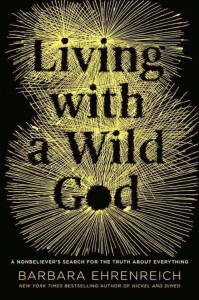Living With a Wild God by Barbara Ehrenreich
 Living With a Wild God: A Nonbeliever’s Search for the Truth about Everything
Living With a Wild God: A Nonbeliever’s Search for the Truth about Everything
by Barbara Ehrenreich
Grand Central Publishing, April 2014
256 pages / $23.50 Buy from Amazon
The first thing I read about Barbara Ehrenreich’s Living With a Wild God, out last month from Hachette Book Group, was the Amazon blurb. There was no question about whether I would read a book by Ehrenreich (Nickel and Dimed, Bait and Switch); she has already, for my money, proven her inherent cultural worth, despite the fact that I don’t always find her arguments entirely convincing. I turned to the blurb merely to identify the topic of this latest offering, and, since my mind was already made up to buy it, I skimmed. A few phrases jumped out, namely “In middle age, she rediscovered the journal she had kept during her tumultuous adolescence…” and “bringing an older woman’s wry and erudite perspective to a young girl’s impassioned obsession…” Those bits, along with the book’s subtitle (“A Nonbeliever’s Search for the Truth About Everything”), were enough for me to imagine the scope of the entire book, which went something like this: Teenaged Barbara keeps a diary that asks questions like “Is there really a God?” and “Should I go to second base with Steve C. after homecoming?” Older Barbara rereads this sweet, mortifying relic and brings some hard-won, grown-up wisdom to the whole ordeal.
I could not have been more off base (or, perhaps, worse at skimming). Living With a Wild God does include small excerpts from some of Barbara’s papers, but calling them a “diary” would be a real stretch, as would calling Barbara anything as conventional as a “teenager.” Barbara was exceptional (her father claimed to have an IQ of 187, and though she says this “put the rest of us at the level of insects by comparison,” you certainly get the sense that she didn’t fall too far from the tree), and her teenage papers are filled with commentary on things like quantum mechanics and the work of Sartre, Camus, Nietzsche, Tchaikovsky, and Borodin (just to name a few). At the age of 15 or 16, she becomes particularly taken with chemistry, summing up the obsession like this:
I am a supersaturated solution, I’m a filter paper who’s had too much. Chemistry is the last thing I think of at night and at 6:30 AM my first conscious thought is about the occurrence of aluminum. And this is only the introduction to the preface to the beginning of the most elementary chemistry. It’s not blood in my veins, it’s a colloidal suspension.
It struck me as I was reading that adolescent Barbara is a dead ringer for Paloma Josse, the twelve-year-old heroine in Muriel Barbery’s The Elegance of the Hedgehog. Both young ladies ask, via their notebooks, “What’s the point of it all?” While the question is common, these two are actually smart enough to take a serious, multi-disciplinary stab at an answer. Both find that answer to be, at least at first, fairly bleak.
One gets the sense, though, that Paloma, despite her suicidal plans, is going to be okay. Structurally, Barbery makes it clear that the child is working her way toward the lonely concierge Renée, and Paloma exhibits just enough childish thinking to lighten the mood. I spent most of Living with a Wild God, however, wanting to give young Barbara a cup of hot chocolate and a big old hug. Her childhood is atrocious. Her parents are hostile alcoholics who value “rationality” above all else, including—it seems—love. With a home life like that, it’s no wonder she became a solipsist at 14.
May 16th, 2014 / 10:00 am
